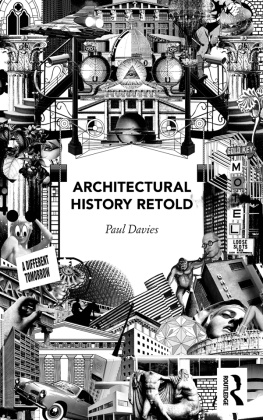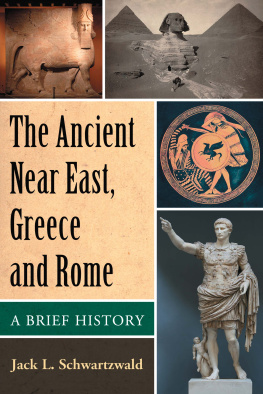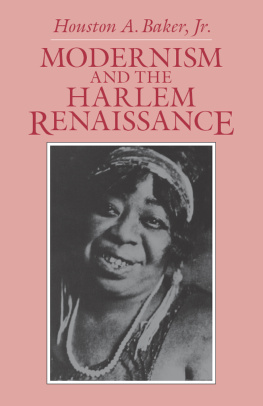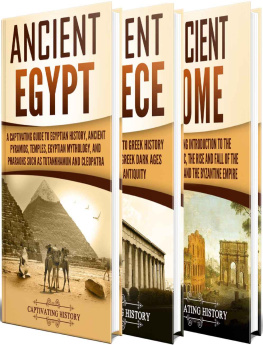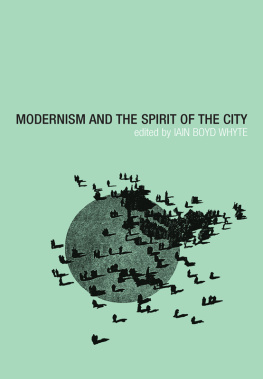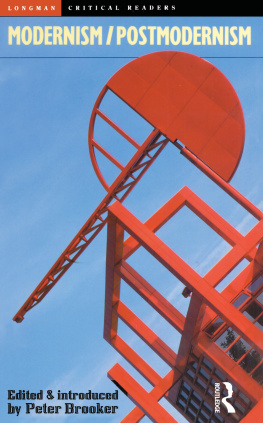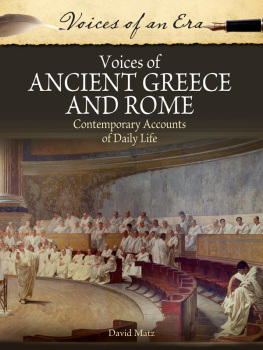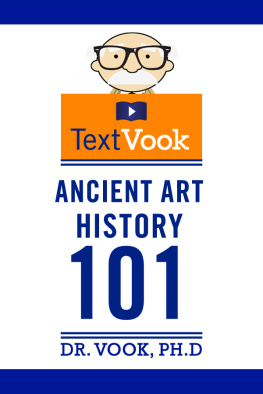Davies Paul - Architectural History Retold
Here you can read online Davies Paul - Architectural History Retold full text of the book (entire story) in english for free. Download pdf and epub, get meaning, cover and reviews about this ebook. City: London, year: 2016, publisher: Taylor & Francis (CAM);Routledge, genre: Romance novel. Description of the work, (preface) as well as reviews are available. Best literature library LitArk.com created for fans of good reading and offers a wide selection of genres:
Romance novel
Science fiction
Adventure
Detective
Science
History
Home and family
Prose
Art
Politics
Computer
Non-fiction
Religion
Business
Children
Humor
Choose a favorite category and find really read worthwhile books. Enjoy immersion in the world of imagination, feel the emotions of the characters or learn something new for yourself, make an fascinating discovery.
- Book:Architectural History Retold
- Author:
- Publisher:Taylor & Francis (CAM);Routledge
- Genre:
- Year:2016
- City:London
- Rating:3 / 5
- Favourites:Add to favourites
- Your mark:
- 60
- 1
- 2
- 3
- 4
- 5
Architectural History Retold: summary, description and annotation
We offer to read an annotation, description, summary or preface (depends on what the author of the book "Architectural History Retold" wrote himself). If you haven't found the necessary information about the book — write in the comments, we will try to find it.
Architectural History Retold — read online for free the complete book (whole text) full work
Below is the text of the book, divided by pages. System saving the place of the last page read, allows you to conveniently read the book "Architectural History Retold" online for free, without having to search again every time where you left off. Put a bookmark, and you can go to the page where you finished reading at any time.
Font size:
Interval:
Bookmark:
First published 2016
by Routledge
2 Park Square, Milton Park, Abingdon, Oxon OX14 4RN
and by Routledge
711 Third Avenue, New York, NY 10017
Routledge is an imprint of the Taylor & Francis Group, an informa business
2016 Paul Davies
The right of Paul Davies to be identified as author of this work has been asserted by him in accordance with sections 77 and 78 of the Copyright, Designs and Patents Act 1988.
All rights reserved. No part of this book may be reprinted or reproduced or utilised in any form or by any electronic, mechanical, or other means, now known or hereafter invented, including photocopying and recording, or in any information storage or retrieval system, without permission in writing from the publishers.
Trademark notice : Product or corporate names may be trademarks or registered trademarks, and are used only for identification and explanation without intent to infringe.
British Library Cataloguing in Publication Data
A catalogue record for this book is available from the British Library
Library of Congress Cataloging-in-Publication Data
Davies, Paul, 1961
Architectural history retold / Paul Davies.
pages cm
Includes bibliographical references and index.
1. ArchitectureHistory. 2. Architecture and society
History. I. Title.
NA200.D36 2015
720.9dc23
2015011529
ISBN: 978-1-138-79946-2 (hbk)
ISBN: 978-1-138-79948-6 (pbk)
ISBN: 978-1-315-75595-3 (ebk)
Typeset in Bembo
by Apex CoVantage, LLC

If we were to read a general architectural history written a half-century ago, say Pevsners Outline of European Architecture , it would feel a lot different from this one. There would be more of it; it would be denser, more technical and harder to read. Even during this research I hesitated to pick Pevsner up from the dusty bookshelves of a secondhand bookshop in Oundle, the sort of place these days youd expect to find it.
So I do not expect students of our age to dip happily into such historical volumes, despite their authority. In our mix-and-match, jumbled-up age, our technology makes us butterflies. Students jump from this to that. Authors jump from this to that, too. As a consequence, ambitious academics strive to complete world histories across vast digital platforms to keep up. Instead, I like to think of this contribution as a kind of horrible history with attitude or as a classic story abbreviated, and it is intended that this book might be read alongside those digital sources so that various images and further investigation might take place while reading it.
There is much to be said for the old grand narrative; it reminds us where weve come from and what we have achieved. To my reasoning, Western architectural history needed to be retold with more cultural infrastructure and less comparative detail, in broad sweeps rather than intricate distinctions. Retold since of course all the material here has come from somewhere and retold because it is necessary to remind ourselves that we have a history not so much to be plundered as secured back in the minds eye as progress. This is a term that has almost disappeared from our lexicon but is nevertheless something that got people interested in the built environment out of bed every morning with a mind for something other than estate agency; which of course, in my more despairing moments, is precisely what I fear architecture might become that or some inadvertently pretentious parlour game.
Furthermore, I tell it as a human story mine as much as everybody elses for human is what we are and because thats what makes history alive and neither some dull abstraction nor an idiotic fairy story. Meanwhile, knowing Mies van der Rohe kept a stash of Edvard Munch prints under his bed tells us a great deal. The personal story is always illuminating if you can get to it, and despite the unfortunately rarefied atmosphere of the great architectural bookshops, architects are not supreme beings, even if some aspects of our academic industry demand we kiss the hem and figure out their parallel universe over thousands of pages of difficult words.
The book derives from a lecture course given to eager undergraduates when they first arrive at a London university to study architecture in the twenty-first century a basically chronological story explained in the context of a culture but it should become clear to anybody that there are many crossovers that belie a straightforward tale and many levels to the notion of culture and architecture. In general I have placed material where I think it fits best and selected the most entertaining examples.
There are always flaws to the construction of history, and I have chosen almost the autobiographical method, opinionated in the sense that presently I may be rather down on Ruskin and up on Morris but with the lurking feeling the situation might possibly reverse with time. The working title of this volume was Architecture: The Unauthorised Biography for quite a long time, until I got fed up with the question as to what might be unauthorised about it or, for that matter, biographical; hence Architectural History Retold is better.
The list of whats left out is scary but serves at least to educate us as to what others include by comparison. In no particular order, I remove everything I havent yet got much of a clue about but some that I have: Byzantium, Ottoman and Moorish architecture, large swathes of the Rococo, Russian Constructivism, postwar British architecture, Deconstruction, German Expressionism, Italian Futurism and Nordic Classicism, just for starters. I hardly mention four of the five architects James Stirling thought were the only great architects Britain had ever produced: Mackintosh, Vanbrugh, Archer, Hawksmoor and Jones. Only one of these makes the fulcrum of my discussion. I even leave out John Soane, whom Stirling left on the bench as a substitute. There is certainly no mention of the Catalan monk Antonio Gaudi. This bizarre reasoning I hope will become clear as the reader progresses.
To make it relevant (a dangerous word), I do one thing that Pevsner would never have done: I say the past never goes away, it just mutates. The historical sense is always here even if you dont self-consciously cultivate it. Our media continually re-represent the past to us, and students need mechanisms to decode what they absorb, to gain a critical perspective, to understand something approximating a road map. This book is my attempt to provide such a thing.
Im sorry there are not more women in our pantheon of flawed genius, but that will change. Denise Scott Brown was lovingly pictured with Robert Venturi in a volume commemorating the National Gallery Extension in 1991, but the caption still read Robert Venturi and His Design. It was pathetic. But I havent gone out of my way to be revisionist, either.
Neither do I dwell on particular race or colonial issues, these being subsumed in to the larger project. When I was studying in the mid-eighties, it was still the ambition of one of my best friends to become the first black partner in a major architectural practice in the UK. At least, thankfully, thats exactly what he became.
And the architecture Im talking about represents a tiny percentage of the work done by architects. This may not have been true of Michelangelo, but these days, however elevated in reputation, architects work in teams, so when I discuss an architect as if it is one person, I do it only for convenience. Looking at some Mies van der Rohe blueprints, a flag set used on site in the construction of the Fellows Building, IIT, Chicago, in 1956 fragile, light-sensitive dyelines that I unroll only once in a blue moon I think not just of Mies but also of the person who drew them. Im transported into this unknown persons world, what he was looking forward to that week, his Friday night and what he was dreading perhaps Mies himself looking over his shoulder that afternoon.
Font size:
Interval:
Bookmark:
Similar books «Architectural History Retold»
Look at similar books to Architectural History Retold. We have selected literature similar in name and meaning in the hope of providing readers with more options to find new, interesting, not yet read works.
Discussion, reviews of the book Architectural History Retold and just readers' own opinions. Leave your comments, write what you think about the work, its meaning or the main characters. Specify what exactly you liked and what you didn't like, and why you think so.

